Gas Boosting
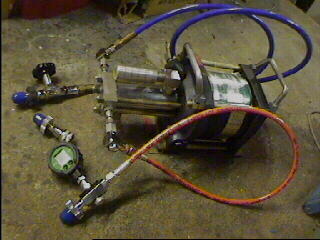 There is a problem with mixed gas diving that most places are only equipped to
blend gases by partial pressure filling. This means that to get an elevated
oxygen mix you bleed a measured amount of oxygen from a supply tank into the
required cylinder and then pump air in on top. This works well with low nitrox
mixes. For example to make 32% you add 32bar of oxygen to an empty tank then in
pump air to 230bar. You can do this easily until your supply tank gets below
40bar and then you have to swap in a new one.
There is a problem with mixed gas diving that most places are only equipped to
blend gases by partial pressure filling. This means that to get an elevated
oxygen mix you bleed a measured amount of oxygen from a supply tank into the
required cylinder and then pump air in on top. This works well with low nitrox
mixes. For example to make 32% you add 32bar of oxygen to an empty tank then in
pump air to 230bar. You can do this easily until your supply tank gets below
40bar and then you have to swap in a new one.
This is not so OK when you want 80% or even pure oxygen. While the supply tanks
may be big, the standard 'J' size is 50L and stands nearly as tall as I do,
they are normally just 200bar so the best you can fill my 7L stage with 100%
from empty is 175bar. The next time guy in the queue gets 153bar and so on.
There are tricks to improve the situation if you have several supply tanks by
drawing as much as you can from your lowest pressure tank first but it still
rapidly becomes a problem if there is a long line of teckies waiting for a fill.
You get used to walking out of the shop with 120 bar and feeling lucky. This
may be OK with a 7L stage where you plan for a margin but with a 3L rebreather
tank it's not so happy as this is your fallback deco gas in case something
breaks.
There is an additional problem with helium in that it all has to come from the
supply tank - at least there is some oxygen in the air you pump. To make a 40%
helium mix to 230bar you need 91bar of helium so if the supply tank is below
99bar it isn't going to make it, even on my tiddly little 3L rebreather tank.
BUT 98bar is virtually HALF FULL! Again you can play the bank trick and use
several cylinders but it is easy to get stuck with sending a lot of expensive
devil gas back because you can't get at it easily.
What you need is an oxygen pump but compressed oxygen is nasty stuff at the
best of times and pumping it is bad news. I won't bore you with the horrible
details as if you are even basic nitrox trained you know the gist and if you
have a blender ticket you know the full horrors.
Let us just say that this is my oxygen pump.
It is a Haskel AG-75. Haskel are the big name in boosters with Aerospace
quality but sadly with Aerospace prices to match. I bought it second hand
because they are about five thousand quid new. Incidentally the whole thing is
40cms end to end and weighs about 10 kilos.

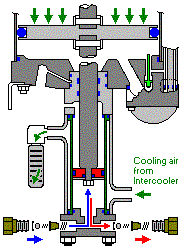 I am told the AG-75 might not be the ideal model for dive gas boosting but it
was available at a price I was prepared to pay and the specification certainly
suits me. What you are looking at is a gas powered piston engine. That's the
cylinder on the left in the top photograph with the big green label. It is run
on up to 10bar and it drives the narrower gas pump on the right with a 75:1
pressure increase. With its rating of 150psi drive pressure it could give
11250psi output (in the old units on the label) that is 10.34bar in to get
775bar out.
I am told the AG-75 might not be the ideal model for dive gas boosting but it
was available at a price I was prepared to pay and the specification certainly
suits me. What you are looking at is a gas powered piston engine. That's the
cylinder on the left in the top photograph with the big green label. It is run
on up to 10bar and it drives the narrower gas pump on the right with a 75:1
pressure increase. With its rating of 150psi drive pressure it could give
11250psi output (in the old units on the label) that is 10.34bar in to get
775bar out.
Now admittedly 775bar could destroy virtually any piece of HP diving
equipment I own but 10bar is a convenient feed being the interstage pressure of
most regs. So to take advantage of that I fitted the drive inlet pipe with the
nipple from a drysuit inflator. To run it I couple up any cylinder to a first
stage that has a drysuit feed, clip the feed onto the inlet and ease the pillar
valve open and off we chuff. Interestingly Haskel warn you not to boost oxygen
beyond 345bar. (Ho Ho Ho).
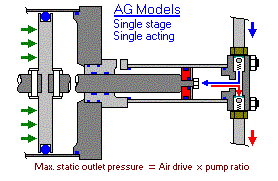 The rest of the plumbing: The first thing I did was to dismantle my old Subaqua
Products blending whip and reuse the parts - that provided a one way valve, the
2 meter blue inlet hose, various fittings and a nice slow feed valve. This got
me started but still left me a few bits short but I phoned them and ordered the
parts from their catalogue including the fancy 300bar swivels that connect the
flexible hoses to the pump. Then off to the Swagelok place in Burgess Hill who
looked at my pile of bits and helpfully worked out what I needed to connect A
to B and finally down the scuba shop for the Apex drysuit nipples to replace
the one I pinched from the spare drysuit inflator.
The rest of the plumbing: The first thing I did was to dismantle my old Subaqua
Products blending whip and reuse the parts - that provided a one way valve, the
2 meter blue inlet hose, various fittings and a nice slow feed valve. This got
me started but still left me a few bits short but I phoned them and ordered the
parts from their catalogue including the fancy 300bar swivels that connect the
flexible hoses to the pump. Then off to the Swagelok place in Burgess Hill who
looked at my pile of bits and helpfully worked out what I needed to connect A
to B and finally down the scuba shop for the Apex drysuit nipples to replace
the one I pinched from the spare drysuit inflator.
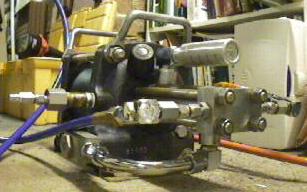 Well the dry suit nipples are only almost the right thread so
they needed to be sawn back a bit and then I ordered a complete new set of
Haskel O-rings and undertook a complete strip and rebuild under oxygen clean
rules. This involved changing some of the parts to oxygen service bits as
I was not quite sure of everything and also removing the external pilot
modification. Sadly the end cap, the bit with the high pressure one way valves,
was obsolete with no spares available and that meant it needed to be swapped
out for the current version. Finally the new hoses were connected up and we
were ready.
Well the dry suit nipples are only almost the right thread so
they needed to be sawn back a bit and then I ordered a complete new set of
Haskel O-rings and undertook a complete strip and rebuild under oxygen clean
rules. This involved changing some of the parts to oxygen service bits as
I was not quite sure of everything and also removing the external pilot
modification. Sadly the end cap, the bit with the high pressure one way valves,
was obsolete with no spares available and that meant it needed to be swapped
out for the current version. Finally the new hoses were connected up and we
were ready.
To use it I couple the donor cylinder to the inlet hose - the blue one. This
has a one way valve and a nice needle valve so I can feed gas slowly -
considered a good move with oxygen. I use a 300bar DIN fitting here but I have
a 300bar female to Bullnose adapter to fit the Air Products 50L 'J' supply
tanks I use when I'm at home. Then I connect the outlet, orange, to the
recipient tank again by 300 bar DIN. I open the recipient valve to check its
starting pressure then the donor which, if it has sufficient pressure, will
just feed through the needle valve and the pump. Once they are equal I couple
the cylinder that is going to power things through the drysuit feed and use its
pillar valve as a throttle control.
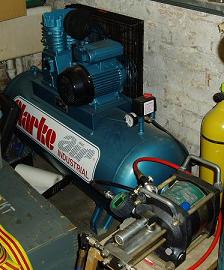 Naturally we only pump a tiny bit of gas per stroke as the output pump is so
slim but it takes in 20cc (0.02L) at the donor pressure per stroke and
compresses it to the current recipient pressure by using 20cc*75 = 1.5L at one
seventy fifth of the recipient pressure. In practice this means that taking a
12L cylinder at 100bar as donor and compressing a fill from it into my 3L
rebreather tanks going from 100bar to 232bar uses about 150bar from my 20L
twinset as power source and takes about 15mins if I do it slowly to stop the
mix getting hot. Add to that that the whole rig is totally mobile and works in
a field or a car park so it can go in the car and, provided I have got enough
air in the twinset or can get a fill, I can decant right down to the bottom of
my donor cylinders although that uses quite a lot of drive gas. At home
naturally I have a big industrial compressor to provide 8 bar in bulk.
Naturally we only pump a tiny bit of gas per stroke as the output pump is so
slim but it takes in 20cc (0.02L) at the donor pressure per stroke and
compresses it to the current recipient pressure by using 20cc*75 = 1.5L at one
seventy fifth of the recipient pressure. In practice this means that taking a
12L cylinder at 100bar as donor and compressing a fill from it into my 3L
rebreather tanks going from 100bar to 232bar uses about 150bar from my 20L
twinset as power source and takes about 15mins if I do it slowly to stop the
mix getting hot. Add to that that the whole rig is totally mobile and works in
a field or a car park so it can go in the car and, provided I have got enough
air in the twinset or can get a fill, I can decant right down to the bottom of
my donor cylinders although that uses quite a lot of drive gas. At home
naturally I have a big industrial compressor to provide 8 bar in bulk.
Well this means that I load the rebreather into the car, add a 12L tank with
extra premixed diluent, a further 12L tank of pure oxygen (full!) and fill the
twinset to power it all I'm set for four days of diving without ever touching
a shop.
One point that needs to be mentioned is that the Haskel design does not totally
exclude the drive gas mixing with the pumped gas. Looking at the schematics and
the complexity of the piston seal you'd wonder how but I guess they are talking
long term use here. If you are powering it from a compressor it needs to be oil
free or at least nitrox clean. I suspect an occasional burst is no problem as
the grease they supply to lube the driver side doesn't look very oxygen clean
but I'll go by the manual just to be safe.
I can not speak too highly of Haskel's technical support and sales people.
Unlike the current fiasco where you cannot buy spares for a simple scuba
regulator they were happy to provide technical data, explanations and, although
they definitely aren't cheap, they supplied all the bits I required by part
number from their detailed drawings which rolled out of my fax. Realise that my
AG-75 is twenty years old and I have restored it to what is to all intents
and purposes new state.
What it is not
Finally let me clear up a few misconceptions. The Haskel is a booster not a
compressor. If I start from the plain 8 bar air I have from my standard air
tool compressor and try to pump that to top up a 100 bar bottle I get 20ccs of
8 bar so 160 surface ccs of gas per stroke. Hence, even in the 3L rebreather
tanks, you only gain a twentieth of a bar per cycle so it's going to take
forever to do a fill. To boost you really want 50 bar so you move one surface
litre a stroke. We tried pumping from bottles less than that to try and save
sending back the dregs of a J of expensive helium but it was a waste of time.
Probably if you have a unit with a lot less compression ratio than mine, so you
take a bigger input of gas each time you could make it worth while as a helium
scavanger but never on air. I have four pumps here. The clean air 320bar
155L/min tank filler, a petrol driven 270bar unit, the oil free 8 bar 150L/min
air tool system and the Haskel. They all have their place and they don't really
overlap. <sigh> I never realised diving would be so
expensive.
Notes on the strip down and clean.
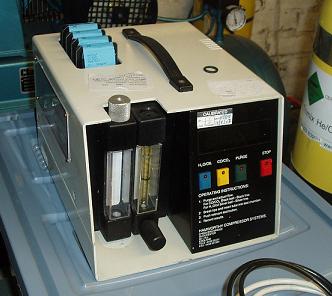 One device I have added to my collection since I got the Haskel is the Gas
Analyser.
One device I have added to my collection since I got the Haskel is the Gas
Analyser.
"What?" you say. "An oxygen meter for Nitrox? A Trimix analyser?"
Nope. I have them but this is a box that feeds gas through Dräger tubes so
you can measure the contamination levels.
Now Dräger tubes are little glass tubes that you first break the seals at
each end on and then pass a measured quantity of gas through. Then you read off
the scale on the front how much of the particular contaminant is present.
This one is made by Hamsworthy and it is basically a first stage in a box
feeding a needle valve followed by one of those 'blow the ball up a tapered
tube' flow rate meters and then a sealed unit to take the Dräger tubes.
Add a timer that knows how long it takes to dose each tube and you have a
portable compressor station measuring unit.
It seemed a good idea at the time but the tubes cost a bit. Still... One less
excuse for killing myself.
 One final trick while I was buying lots of compressed air fittings was to solve
my perennial blowing up motorbike tyres problem. Another dry suit inflator
nipple is mounted in the bottom of this little goody that I saw on eBay. Yes
it's one of those garage tyre inflators that always hang off the machine
which takes 20p. But you're wearing thick bike gloves, the 20ps
are under all the water/wind proof kit you're wrapped in and it's
raining. All this compressed gas I have hanging about the house and at last
it's finally working for me.
One final trick while I was buying lots of compressed air fittings was to solve
my perennial blowing up motorbike tyres problem. Another dry suit inflator
nipple is mounted in the bottom of this little goody that I saw on eBay. Yes
it's one of those garage tyre inflators that always hang off the machine
which takes 20p. But you're wearing thick bike gloves, the 20ps
are under all the water/wind proof kit you're wrapped in and it's
raining. All this compressed gas I have hanging about the house and at last
it's finally working for me.
 There is a problem with mixed gas diving that most places are only equipped to
blend gases by partial pressure filling. This means that to get an elevated
oxygen mix you bleed a measured amount of oxygen from a supply tank into the
required cylinder and then pump air in on top. This works well with low nitrox
mixes. For example to make 32% you add 32bar of oxygen to an empty tank then in
pump air to 230bar. You can do this easily until your supply tank gets below
40bar and then you have to swap in a new one.
There is a problem with mixed gas diving that most places are only equipped to
blend gases by partial pressure filling. This means that to get an elevated
oxygen mix you bleed a measured amount of oxygen from a supply tank into the
required cylinder and then pump air in on top. This works well with low nitrox
mixes. For example to make 32% you add 32bar of oxygen to an empty tank then in
pump air to 230bar. You can do this easily until your supply tank gets below
40bar and then you have to swap in a new one.
 I am told the AG-75 might not be the ideal model for dive gas boosting but it
was available at a price I was prepared to pay and the specification certainly
suits me. What you are looking at is a gas powered piston engine. That's the
cylinder on the left in the top photograph with the big green label. It is run
on up to 10bar and it drives the narrower gas pump on the right with a 75:1
pressure increase. With its rating of 150psi drive pressure it could give
11250psi output (in the old units on the label) that is 10.34bar in to get
775bar out.
I am told the AG-75 might not be the ideal model for dive gas boosting but it
was available at a price I was prepared to pay and the specification certainly
suits me. What you are looking at is a gas powered piston engine. That's the
cylinder on the left in the top photograph with the big green label. It is run
on up to 10bar and it drives the narrower gas pump on the right with a 75:1
pressure increase. With its rating of 150psi drive pressure it could give
11250psi output (in the old units on the label) that is 10.34bar in to get
775bar out. The rest of the plumbing: The first thing I did was to dismantle my old Subaqua
Products blending whip and reuse the parts - that provided a one way valve, the
2 meter blue inlet hose, various fittings and a nice slow feed valve. This got
me started but still left me a few bits short but I phoned them and ordered the
parts from their catalogue including the fancy 300bar swivels that connect the
flexible hoses to the pump. Then off to the Swagelok place in Burgess Hill who
looked at my pile of bits and helpfully worked out what I needed to connect A
to B and finally down the scuba shop for the Apex drysuit nipples to replace
the one I pinched from the spare drysuit inflator.
The rest of the plumbing: The first thing I did was to dismantle my old Subaqua
Products blending whip and reuse the parts - that provided a one way valve, the
2 meter blue inlet hose, various fittings and a nice slow feed valve. This got
me started but still left me a few bits short but I phoned them and ordered the
parts from their catalogue including the fancy 300bar swivels that connect the
flexible hoses to the pump. Then off to the Swagelok place in Burgess Hill who
looked at my pile of bits and helpfully worked out what I needed to connect A
to B and finally down the scuba shop for the Apex drysuit nipples to replace
the one I pinched from the spare drysuit inflator. Well the dry suit nipples are only almost the right thread so
they needed to be sawn back a bit and then I ordered a complete new set of
Haskel O-rings and undertook a complete strip and rebuild under oxygen clean
rules. This involved changing some of the parts to oxygen service bits as
I was not quite sure of everything and also removing the external pilot
modification. Sadly the end cap, the bit with the high pressure one way valves,
was obsolete with no spares available and that meant it needed to be swapped
out for the current version. Finally the new hoses were connected up and we
were ready.
Well the dry suit nipples are only almost the right thread so
they needed to be sawn back a bit and then I ordered a complete new set of
Haskel O-rings and undertook a complete strip and rebuild under oxygen clean
rules. This involved changing some of the parts to oxygen service bits as
I was not quite sure of everything and also removing the external pilot
modification. Sadly the end cap, the bit with the high pressure one way valves,
was obsolete with no spares available and that meant it needed to be swapped
out for the current version. Finally the new hoses were connected up and we
were ready. Naturally we only pump a tiny bit of gas per stroke as the output pump is so
slim but it takes in 20cc (0.02L) at the donor pressure per stroke and
compresses it to the current recipient pressure by using 20cc*75 = 1.5L at one
seventy fifth of the recipient pressure. In practice this means that taking a
12L cylinder at 100bar as donor and compressing a fill from it into my 3L
rebreather tanks going from 100bar to 232bar uses about 150bar from my 20L
twinset as power source and takes about 15mins if I do it slowly to stop the
mix getting hot. Add to that that the whole rig is totally mobile and works in
a field or a car park so it can go in the car and, provided I have got enough
air in the twinset or can get a fill, I can decant right down to the bottom of
my donor cylinders although that uses quite a lot of drive gas. At home
naturally I have a big industrial compressor to provide 8 bar in bulk.
Naturally we only pump a tiny bit of gas per stroke as the output pump is so
slim but it takes in 20cc (0.02L) at the donor pressure per stroke and
compresses it to the current recipient pressure by using 20cc*75 = 1.5L at one
seventy fifth of the recipient pressure. In practice this means that taking a
12L cylinder at 100bar as donor and compressing a fill from it into my 3L
rebreather tanks going from 100bar to 232bar uses about 150bar from my 20L
twinset as power source and takes about 15mins if I do it slowly to stop the
mix getting hot. Add to that that the whole rig is totally mobile and works in
a field or a car park so it can go in the car and, provided I have got enough
air in the twinset or can get a fill, I can decant right down to the bottom of
my donor cylinders although that uses quite a lot of drive gas. At home
naturally I have a big industrial compressor to provide 8 bar in bulk. One device I have added to my collection since I got the Haskel is the Gas
Analyser.
One device I have added to my collection since I got the Haskel is the Gas
Analyser. One final trick while I was buying lots of compressed air fittings was to solve
my perennial blowing up motorbike tyres problem. Another dry suit inflator
nipple is mounted in the bottom of this little goody that I saw on eBay. Yes
it's one of those garage tyre inflators that always hang off the machine
which takes 20p. But you're wearing thick bike gloves, the 20ps
are under all the water/wind proof kit you're wrapped in and it's
raining. All this compressed gas I have hanging about the house and at last
it's finally working for me.
One final trick while I was buying lots of compressed air fittings was to solve
my perennial blowing up motorbike tyres problem. Another dry suit inflator
nipple is mounted in the bottom of this little goody that I saw on eBay. Yes
it's one of those garage tyre inflators that always hang off the machine
which takes 20p. But you're wearing thick bike gloves, the 20ps
are under all the water/wind proof kit you're wrapped in and it's
raining. All this compressed gas I have hanging about the house and at last
it's finally working for me.